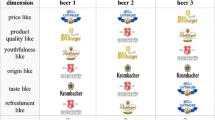Abstract
This research shows that consumers’ intra-brand choices (e.g., Mercedes C330 vs. C340) can be affected by exposure to a competitor alphanumeric brand name that forms an incidental trend with the numbers in the focal brand names (e.g., BMW320i or BMW350i). We propose and test two mechanisms. First, when no attribute information is available, the competitor brand can make the numerical trends formed by brand names salient and meaningful, and increase the preference for higher brands (e.g., Mercedes C340). Second, when attribute values are negatively correlated with brands, exposure to the competitor brand name can trigger brand-attribute magnitude tradeoffs. In five experiments, we demonstrate that our predictions hold when there are no intrinsic brand-attribute associations, and even when the competitor brand is not available for choice. We identify competitive categorization as a boundary condition and demonstrate that the effect diminishes when consumers do not categorize the nonfocal option as a competitor.
Similar content being viewed by others
References
Burton, S., & Zinkhan, G. M. (1987). Changes in consumer choice: further investigation of similarity and attraction effects. Psychology and Marketing, 4, 255–265.
Dehaene, S. (1997). The number sense. NY: Oxford University Press.
Fias, W., & Fischer, M. (2005). Spatial representation of numbers. In J. I. D. Campbell (Ed.), Handbook of mathematical cognition (pp. 43–54). NY: Psychology Press.
Gunasti, K., & Ozcan, T. (2014). Consumer reactions to round numbers in brand names. Marketing Letters. doi:10.1007/s11002-014-9337-7.
Gunasti, K., & Ross, W. (2010). How and when alphanumeric brand names affect consumer preferences. Journal of Marketing Research, 47, 1177–1192.
Huber, J., & Puto, C. (1983). Market boundaries and product choice: illustrating attraction and substitution effects. Journal of Consumer Research, 10, 31–44.
Isen, A., & Diamond, G. (1989). Affect and automaticity. In J. S. Uleman & J. A. Bargh (Eds.), Unintended thought: limits of awareness, intention, and control (pp. 124–154). NY: The Guilford Press.
Johnson, M. (1988). Comparability and hierarchical processing in multialternative choice. Journal of Consumer Research, 15, 303–314.
Kahneman, D. (1973). Attention and effort. Englewood Cliffs: Prentice-Hall.
Keller, K., Heckler, S., & Houston, M. (1998). The effects of brand name suggestiveness on advertising recall. Journal of Marketing, 62, 48–57.
Kivetz, R., & Simonson, I. (2000). The effects of incomplete information on consumer choice. Journal of Marketing Research, 3, 427–448.
Monroe, K. B., & Cox, J. L. (2001). Pricing practices that endanger profits. Marketing Management, 10(3), 42–46.
Pavia, T., & Costa, J. (1993). The winning number: consumer perceptions of alpha-numeric brand names. Journal of Marketing, 57, 85–98.
Schwarz, N., & Bless, H. (1992). Constructing reality and its alternatives: assimilation and contrast effects in the construction of social judgments. In L. Martin & A. Tesser (Eds.), The construction of social judgment (pp. 217–245). NJ: Lawrence Erlbaum Associates.
Simonson, I. (1989). Choice based on reasons: the case of attraction and compromise effects. Journal of Consumer Research, 16, 158–174.
Treisman, A., & Gelade, G. (1980). A feature-integration theory of attention. Cognitive Psychology, 12(1), 97–136.
Tversky, A. (1977). Features of similarity. Psychological Review, 84(4), 327–352.
Yan, D., & Duclos, R. (2013). Making sense of numbers: effects of alphanumeric brands on consumer inference. International Journal of Research in Marketing, 30(2), 179–184.
Acknowledgments
Authors would like to thank William Ross, Nicholas Lurie, Chris Janiszewski, Hans Baumgartner, Robin Coulter, Margaret Meloy, Baler Bilgin, David E. Sprott, Yany Grégoire, D'Wayne Hodgin, Gaia Rubera and David Norton for their feedback on earlier drafts of the manuscript. This research was partially supported by the Competitive Summer Research Grants funded by University of Connecticut and University of Idaho. Please address all correspondence to the first author.
Author information
Authors and Affiliations
Corresponding author
Appendix
Appendix
SAMPLE ONLINE PORTAL

Rights and permissions
About this article
Cite this article
Gunasti, K., Devezer, B. How competitor brand names affect within-brand choices. Mark Lett 27, 715–727 (2016). https://doi.org/10.1007/s11002-015-9374-x
Published:
Issue Date:
DOI: https://doi.org/10.1007/s11002-015-9374-x




